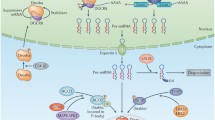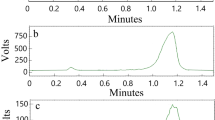Abstract
Antisense oligonucleotides have been used for a variety of purposes in microRNA (miRNA) research including functional evaluation, target recognition, and gene studies. Although several 99mTc-radiolabeled oligonucleotides have been reported in antisense imaging, none of those were related to miRNA tracing. Moreover, separation after labeling was always required to achieve acceptable radiochemical purity. In this study, we prepared a 99mTc-radiolabeled oligonucleotide under optimized conditions for the purpose of tracing miRNA. A 22mer anti-miRNA oligonucleotide (AMO) was designed completely complementary to the sequence of mature miR-21. AMO probe modified with 2′-O-Methyl and phosphorothioate backbone was designed and synthesized. This probe was conjugated with a bifunctional chelator S-acetylmercaptoacetyltriglycine (NHS-MAG3) via a primary amine on 5′-end. Furthermore, it was radiolabeled and its optimization labeling conditions were performed by varying the amount of stannous ion, 99mTc-pertecnetate, and reaction time, respectively. Finally, the labeled product was identified by gel electrophoresis and evaluated for its serum stability. The AMO was synthesized with partial 2′-OMe and phosphorothioate modification to improve its stability. Excess of MAG3 impurity was removed by precipitation of tin and MAG3 after the conjugation. The labeling efficiency reached 97 % under the optimal reaction conditions of 2 μg/μL SnCl2·2H2O addition, 99mTc solution with high specific activity, and 90-min reaction at room temperature. Gel electrophoresis confirmed that the peak of radioactivity located the same position of oligomer, which identified the successful radiolabeling. After incubated with human fresh serum for 12 h, labeled AMO showed good stability with high radiochemical purity and no significant degradation. A 99mTc-labeled AMO targeting miR-21 can be prepared with high labeling efficiency under optimized conditions, which provides a good support for the future use of miRNA-targeted tracing and imaging.






Similar content being viewed by others
References
Stenvang, J., Petri, A., Lindow, M., et al. (2012). Inhibition of microRNA function by antimiR oligonucleotides. Silence, 3(1), 1.
Sassen, S., Miska, E. A., & Caldas, C. (2008). MicroRNA: implications for cancer. Virchows Archiv, 452(1), 1–10.
Medina, P. P., Nolde, M., & Slack, F. J. (2010). OncomiR addiction in an in vivo model of microRNA-21-induced pre-B-cell lymphoma. Nature, 467(7311), 86–90.
Skotland, T. (2012). Molecular imaging: challenges of bringing imaging of intracellular targets into common clinical use. Contrast Media & Molecular Imaging, 7(1), 1–6.
Wang, F., Niu, G., Chen, X., et al. (2011). Molecular imaging of microRNAs. European Journal of Nuclear Medicine and Molecular Imaging, 38(8), 1572–1579.
Hernandez, R., Orbay, H., & Cai, W. (2013). Molecular imaging strategies for in vivo tracking of microRNAs: a comprehensive review. Current Medicinal Chemistry, 20(29), 3594–3603.
Stenvang, J., & Kauppinen, S. (2008). MicroRNAs as targets for antisense-based therapeutics. Expert Opinion on Biological Therapy, 8(1), 59–81.
Banerjee, S., Pillai, M. R., & Ramamoorthy, N. (2001). Evolution of Tc-99m in diagnostic radiopharmaceuticals. Seminars in Nuclear Medicine, 31(4), 260–277.
Iyer, A. K., & He, J. (2011). Radiolabeled oligonucleotides for antisense imaging. Current Organic Synthesis, 8(4), 604–614.
Griffiths-Jones, S., Grocock, R. J., van Dongen, S., et al. (2006). miRBase: microRNA sequences, targets and gene nomenclature. Nucleic Acids Research, 34(Database issue), D140–D144.
Hutvágner, G., Simard, M. J., Mello, C. C., et al. (2004). Sequence-specific inhibition of small RNA function. PLoS Biology, 2(4), E98.
Davis, S., Propp, S., Freier, S. M., et al. (2009). Potent inhibition of microRNA in vivo without degradation. Nucleic Acids Research, 37(1), 70–77.
Kang, L., Wang, R. F., Yan, P., et al. (2010). Noninvasive Visualization of RNA Delivery With 99Tcm-Radiolabeled Small-Interference RNA in Tumor Xenografts. Journal of Nuclear Medicine, 51(6), 978–986.
Liu, M., Wang, R. F., Zhang, C. L., et al. (2007). Noninvasive imaging of human telomerase reverse transcriptase (hTERT) messenger RNA with 99Tcm-radiolabeled antisense probes in malignant tumors. Journal of Nuclear Medicine, 48(12), 2028–2036.
Wang, Y., Liu, G., & Hnatowich, D. J. (2006). Methods for MAG3 conjugation and 99Tcm radiolabeling of biomolecules. Nature Protocols, 1(3), 1477–1480.
Bushati, N., & Cohen, S. M. (2007). microRNA functions. Annual Review of Cell and Developmental Biology, 23, 175–205.
Si, M. L., Zhu, S., Wu, H., et al. (2007). miR-21-mediated tumor growth. Oncogene, 26(19), 2799–2803.
Lee, H. W., Lee, E. H., Ha, S. Y., et al. (2012). Altered expression of microRNA miR-21, miR-155, and let-7a and their roles in pulmonary neuroendocrine tumors. Pathology International, 62(9), 583–591.
Chen, L., Wang, Y., Cheng, D., et al. (2013). 99mTc-MORF oligomers specific for bacterial ribosomal RNA as potential specific infection imaging agents. Bioorganic and Medcinal Chemistry, 21(21), 6523–6530.
Lennox, K. A., & Behlke, M. A. (2010). A direct comparison of anti-microRNA oligonucleotide potency. Pharmaceutical Research, 27(9), 1788–1799.
Ma, C., Kang, L., & Wang, R. F. (2013). Progress of researches on technetium-99m radiolabeling methods in antisense imaging. Journal of Nuclear and Radiochemistry, 35(5), 257–262.
Liu, G., Dou, S., Liu, Y., et al. (2011). Unexpected side products in the conjugation of an amine-derivatized morpholino oligomer with p-isothiocyanate benzyl DTPA and their removal. Nuclear Medicine and Biology, 38(2), 159–163.
Guo, Z., Zhang, P., Song, M., et al. (2014). Synthesis and preliminary evaluation of novel (99m)Tc-labeled folate derivative via click reaction for SPECT imaging. Applied Radiation and Isotopes, 91, 24–30.
Banerjee, S. R., Maresca, K. P., Francesconi, L., et al. (2005). New directions in the coordination chemistry of 99mTc: a reflection on technetium core structures and a strategy for new chelate design. Nuclear Medicine and Biology, 32(1), 1–20.
Li, Y. C., Tan, T. Z., Zheng, J. G., et al. (2008). Anti-sense oligonucleotide labeled with technetium-99m using hydrazinonictinamide derivative and N-hydroxysuccinimidyl S-acetylmercaptoacetyltriglycline: a comparison of radiochemical behaviors and biological properties. World Journal of Gastroenterology, 14(14), 2235–2240.
Liu, G., Zhang, S., He, J., et al. (2002). Improving the labeling of S-acetyl NHS-MAG(3)-conjugated morpholino oligomers. Bioconjugate Chemistry, 13(4), 893–897.
Qin, G., Zhang, Y., Cao, W., et al. (2005). Molecular imaging of atherosclerotic plaques with technetium-99m-labelled antisense oligonucleotides. European Journal of Nuclear Medicine and Molecular Imaging, 32(1), 6–14.
Hnatowic, D. J., & Nakamura, K. (2006). The influence of chemical structure of DNA and other oligomer radiopharmaceuticals on tumor delivery. Current Opinion in Molecular Therapeutics, 8(2), 136–143.
Acknowledgments
This study was supported by grants from the National Natural Science Foundation of China (NSFC 81101065, 31100604, 81441051 and 81472589), National Major Scientific Equipment Special Fund (2011YQ03011409), the Higher Education Doctoral Program of China Research Fund for New Teacher (20110001120043), Beijing Capital Special Development Application Program (Z141107002514159), and Beijing Nova Program (Z141102001814055).
Author information
Authors and Affiliations
Corresponding authors
Additional information
Lei Kang, Xiao-jie Xu, and Chao Ma have contributed equally to this work.
Rights and permissions
About this article
Cite this article
Kang, L., Xu, Xj., Ma, C. et al. Optimized Preparation of a 99mTc-Radiolabeled Probe for Tracing MicroRNA. Cell Biochem Biophys 71, 905–912 (2015). https://doi.org/10.1007/s12013-014-0281-1
Published:
Issue Date:
DOI: https://doi.org/10.1007/s12013-014-0281-1




